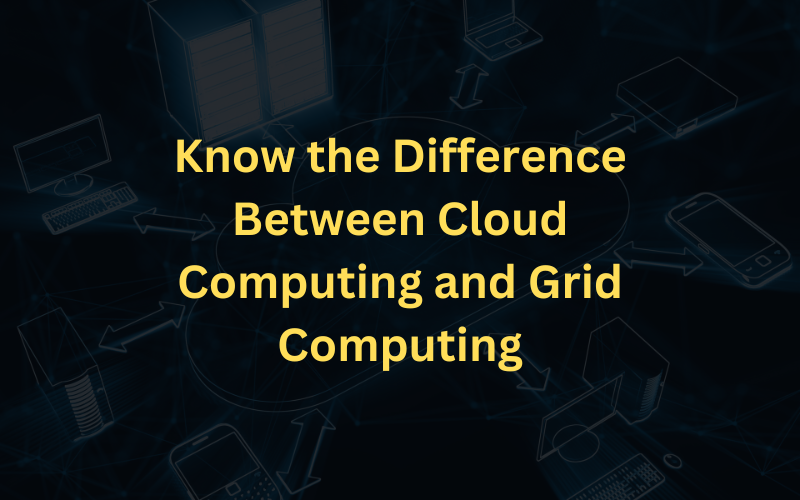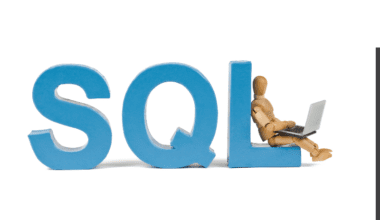Summary: This blog explains the difference between cloud computing and grid computing in simple terms. Learn their architecture, benefits, and limitations. Discover how each impacts industries like data science and make smarter tech decisions. Ideal for beginners and tech enthusiasts exploring modern computing trends.
Introduction
Welcome to our exploration, where we highlight the difference between cloud computing and grid computing. If you’ve ever wondered about these buzzwords, you’ve come to the right place. I want you to leave this blog feeling confident, whether you’re a tech newbie or an experienced geek.
We’ll show what each term means, how they affect our daily lives, and why understanding these two computing paradigms matters. By the end, you’ll see how they guide modern technology, helping you make wiser personal or professional growth decisions. Let’s dive in and demystify these fascinating innovations together! Join me on this journey!
Key Takeaways
- Cloud computing is centralised and service-based, offering flexibility, scalability, and ease of access.
- Grid computing is distributed, combining many systems to handle high-performance, data-intensive tasks.
- Cloud services operate on pay-as-you-go models, while grid computing often uses free, shared resources.
- Both technologies support data science, enabling powerful computation, storage, and model deployment.
- Pickl.AI’s data science courses can help you master and apply these computing paradigms in real-world projects.
What Exactly Is Cloud Computing?
Cloud computing means using the Internet to store, manage, and process data instead of relying on your personal computer or local servers. Simply put, it allows you to use services like file storage, software, and data processing over the Internet, which is often referred to as “the cloud.”
Instead of buying and maintaining expensive computer systems, you can rent the technology you need from cloud service providers like Amazon Web Services (AWS), Microsoft Azure, or Google Cloud.
Three Main Types of Cloud Services
- IaaS (Infrastructure as a Service): You rent basic tools like storage and servers. It’s like leasing land to build your own house.
- PaaS (Platform as a Service): This offers both tools and a platform to build and run your applications. It’s like renting a ready-to-use kitchen to cook your recipes.
- SaaS (Software as a Service): You use ready-made software over the internet, like Gmail or Zoom. You don’t have to install anything.
Real-Life Examples
People use cloud computing every day — storing photos on Google Drive, watching Netflix, attending Zoom meetings, or editing documents on Microsoft 365.
Market Growth
Cloud computing is growing rapidly. In 2024, the market was valued at USD 752.44 billion. Experts expect it to grow by 20.4% annually from 2025 to 2030, showing how important and useful this technology has become.
Benefits of Cloud Computing
Here are some of the main benefits of using cloud computing:
- Scalability: You can easily increase or decrease your storage or computing power based on your needs—no need to invest in extra hardware.
- On-Demand Self-Service: You can quickly start or stop services by yourself, without needing help from IT experts.
- Cost-Effective: You only pay for what you use, which helps save money. There’s no need to spend a lot on buying and maintaining physical systems.
- Access Anytime, Anywhere: As long as you have an internet connection, you can use cloud services from any device—whether you’re at home, work, or on the go.
Rapid Elasticity: Cloud resources can grow or shrink almost instantly, helping you handle changes quickly and smoothly.
Limitations of Cloud Computing
Like any technology, cloud computing also has a few downsides. While it offers flexibility and convenience, there are some limitations that users should know, especially when relying on it for daily tasks or business operations. Here are some of the key drawbacks explained in simple terms:
- Dependence on Internet Connection: Cloud computing works only when connected to the internet. If your connection is slow or breaks down, you may be unable to access your files or services.
- Needs High-Speed Internet: To use cloud services smoothly, especially for large files or live tools, you need a fast and reliable internet connection.
- Limited Control: Users don’t have full control over the system that runs their data. The cloud provider manages everything behind the scenes.
- Security Concerns: Storing data online can increase the risk of hacking or data leaks.
- Unexpected Downtime: Sometimes, cloud services may face outages, making them temporarily unavailable.
What Exactly is Grid Computing?
Grid computing is a method where many computers work together to solve one big problem. Instead of using one powerful machine, grid computing connects several normal computers through a network. These computers share their processing power, storage, and other resources to complete tasks faster and more efficiently.
Think of it like a group project—each computer takes on a small part of the work, and together, they finish the job much quicker than one person could alone.
Where Is Grid Computing Used?
Grid computing is commonly used in areas that need much computing power. For example, researchers use it to study climate change, run simulations, or analyse medical data. It’s also helpful in fields like aerospace, finance, and drug discovery where large amounts of data must be processed.
A real-world example is the SETI@home project, where people allowed their home computers to help search for signs of life in space.
Market Growth
The grid computing industry is steadily growing. In 2022, the global market was worth USD 3.6 billion. It is expected to grow at a 17.10% rate each year from 2023 to 2031, proving that more industries are turning to grid computing to meet their high-performance needs.
Benefits of Grid Computing
Here are some simple benefits of grid computing:
- Better Use of Resources: Grid computing uses unused computer power from different machines. This helps avoid waste and ensures high resource utilisation.
- Faster Processing: It breaks down large tasks into smaller parts and runs them simultaneously on multiple systems. This process, known as parallel processing, saves time and speeds up the work.
- Grows with Your Needs: It is scalable, meaning you can add more computers to the grid as the demand increases.
- Cost-Effective: It reduces the need to buy expensive hardware by using existing machines.
- Improved Reliability: If one computer fails, others can take over, keeping the system running smoothly.
Limitations of Grid Computing
While grid computing offers a smart way to use the combined power of many computers, it also comes with a few challenges. These issues can make it harder for businesses or users to rely on grid computing for all their tasks fully. Here are some of the key limitations explained in simple terms:
- Still Developing Software: The software used in grid computing is still growing and improving. It may not always work smoothly or have all the features people need.
- Complex to Set Up and Use: Grid computing connects many different systems. This can make things complicated, especially for people without technical skills.
- Less Flexibility: Adjusting or changing the setup in grid computing is not always easy. Once the system is built, making changes can be tough.
- Security Concerns: Sharing data across many systems increases the risk of hacking or data leaks.
- Requires Strong Internet: A stable and fast internet connection is a must. Without it, the system may not work well.
Key Distinctions
Cloud computing and grid computing may sound similar, but they are built on different ideas and serve different purposes. In this section, we’ll explore how these two technologies differ in terms of structure, flexibility, cost, and usage. Even if you don’t come from a technical background, you’ll find it easy to follow along.
Architecture: Centralized vs. Distributed
Cloud computing follows a client-server architecture, meaning all services and data come from a central location. Think of it like getting electricity from a power grid—you just plug in and use it.
On the other hand, grid computing is a distributed system. Here, multiple computers work together and share resources to solve one large problem. It’s like a group of people each bringing ingredients to cook a meal together.
Control and Resource Usage
In cloud computing, everything is centrally managed. The cloud provider exercises all control. Resources such as storage, applications, and computing power are used in a centralised manner.
Grid computing is decentralised, where each computer in the network contributes its resources. It works in a collaborative pattern, with no single point of control.
Flexibility and Accessibility
Cloud computing is more flexible—you can increase or decrease resources based on your needs. It’s also highly accessible, usually through a web browser or mobile app.
Grid computing is less flexible and often less accessible, since it requires special software (called middleware) to connect systems.
Cost and Service Orientation
Cloud services are pay-as-you-go. You only pay for what you use, like renting a car. They’re service-oriented, offering models like IaaS, PaaS, and SaaS.
Grid computing is generally free to use, especially in academic or research settings. It’s application-oriented, focusing on performing large-scale tasks through distributed computing.
Which One Fits Your Needs Best?
Choosing between cloud computing and grid computing depends on what your project or business really needs. Cloud computing is a great choice if you want something quick to set up, easy to use, and that can grow with your business. It works well for companies that want flexibility and pay only for what they use.
On the other hand, if you have access to several computers and need to share heavy tasks, grid computing can save money and speed up the process. Ultimately, pick the option that best matches your goals, budget, and the type of work involved.
Let That Sink In
Understanding the difference between cloud computing and grid computing helps you choose the right technology for your goals. While cloud computing offers scalability, ease of use, and flexible pricing, grid computing is ideal for collaborative, high-performance tasks.
Both play crucial roles in the evolving tech world, especially in data science, where storage, processing, and analysis are key. To master such technologies and build a future-proof career, consider enrolling in industry-relevant data science courses by Pickl.AI.
These courses help you apply computing concepts in real-world scenarios, whether it’s building models on the cloud or managing distributed data processing systems.
Frequently Asked Questions
What is the main difference between cloud computing and grid computing?
Cloud computing is centralized and service-based, offering resources via the internet. Grid computing is distributed, combining multiple systems to process large-scale tasks. Cloud is more flexible, while grid is more suitable for computation-heavy problems like simulations or scientific research.
How does cloud computing support data science?
Cloud computing supports data science by offering scalable storage, computing power, and tools like Jupyter notebooks, databases, and ML platforms. It allows analysts to process large datasets, run models, and collaborate from anywhere, making it ideal for real-time, on-demand analytics and model deployment.
Can grid computing be used in business settings?
Yes, grid computing can benefit businesses that need to process massive data workloads, such as simulations or big data analytics. However, it’s more common in research and academic environments due to setup complexity and the need for distributed systems expertise and resources.




